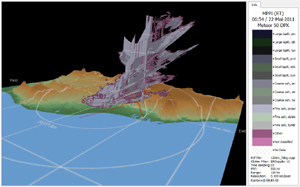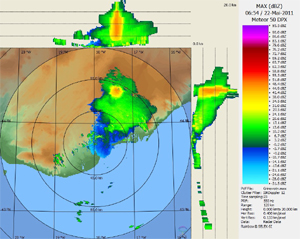Selex-SI signs a contract with the Icelandic Meteorological Office Mobile weather radar for volcanic ash plume monitoring

Selex Systems Integration GmbH was recently awarded a contract to supply one mobile dual-polarized METEOR 50DX weather radar to the Icelandic Meteorological Office (IMO).

 Following the eruption of the Eyjafjallajökull volcano in April and May 2010, which caused major disruption to air traffic over Europe, the Icelandic Meteorological Office started the process of procuring a mobile weather radar that could be positioned near erupting volcanoes.
Following the eruption of the Eyjafjallajökull volcano in April and May 2010, which caused major disruption to air traffic over Europe, the Icelandic Meteorological Office started the process of procuring a mobile weather radar that could be positioned near erupting volcanoes.The radar will be deployed at short notice in response to volcanic activity and use the data acquired to detect and track the plume of volcanic ash. Warning will be issued to the aviation industry about the location of the volcanic ash plume including its track and altitude. The data will be supplied to the London Volcanic Ash Advisory Centre, which is responsible for monitoring ash from volcanoes in the north-eastern part of the North Atlantic. This is some of the busiest airspace in the world.
The contract involves the delivery of a state-of-the-art dual polarized X-Band radar installed on a trailer and is specially designed to withstand the harsh artic conditions and difficult road surfaces found in Iceland. The new radar system is due to be delivered in winter 2011.
While the customized radar is being manufactured, the IMO has obtained a mobile version of Selex s METEOR 50DX from the Italian Department of Civil Protection.
Selex's Meteorological Data Processing Software Rainbow 5 contains a Volcanic Ash Detection and Classification (VADC) algorithm which operates on polarimetric radar data and was developed for the METEOR 50DX radar system. Two such systems are operated by the Italian Civil Protection Department (DPC) to monitor the volcanic activity of Mt. Etna. One of these systems is currently on loan to the Icelandic Meteorological Office and detected the May eruption of Grimsvotn. As shown in the images below, the detectable ash cloud reached altitudes up to about 20 km on early May 22nd, and the ash was classified by the Rainbow-5 VADC mainly as oblate fine and coarse ash.


.png)





.jpg)
Comments
There are no comments yet for this item
Join the discussion